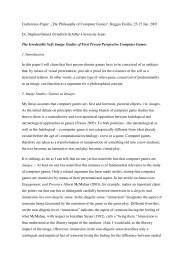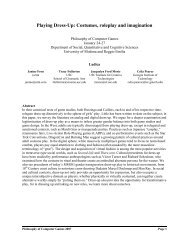Charles Sanders Peirce and the Mind-Body-World Relation
Charles Sanders Peirce and the Mind-Body-World Relation
Charles Sanders Peirce and the Mind-Body-World Relation
You also want an ePaper? Increase the reach of your titles
YUMPU automatically turns print PDFs into web optimized ePapers that Google loves.
perspectivising influence on <strong>the</strong> on-going flux of phenomenological experience. Thisgeneral way of thinking about things strikes me also as ra<strong>the</strong>r similar to <strong>the</strong> notion ofhow attractors function to exert a pull on certain processes in conceptual, or o<strong>the</strong>rtypes of phase space, as suggested by Peter Bøgh Anderson recently in relation to hissemiotic <strong>the</strong>ory for modelling genres as dynamic self-organizing systems (see BøghAndersen 2000)At <strong>the</strong> same time, <strong>the</strong> body-mind complex remains open for future re-organisations ofits habituated (<strong>and</strong> habituating) configurations of categorising relations at any giventime. According to this view, relational reorganisations result from semiotic processesinstigated by certain types of (surprising) experiences, allowing for <strong>the</strong> developmentof innovative configurations of perspectival filterings related to, but not isometricwith. o<strong>the</strong>r self-organizing semiotic processes in <strong>the</strong> natural environment external to<strong>the</strong> more “local” (both subjective <strong>and</strong> intersubjective) perspectivising environmentthat each mind-body nexus offers through its own currently habituated ways oforganizing <strong>and</strong> categorizing signs in terms of meanings.We have seen that in a living, breathing world it is not, seen from <strong>Peirce</strong>’s point ofview, sufficient to operate with dichotomised distinctions between pairs of “entities”such as mind <strong>and</strong> body, or body <strong>and</strong> world. <strong>Mind</strong>, body <strong>and</strong> world are seen by <strong>Peirce</strong>as living <strong>and</strong> moving toge<strong>the</strong>r in a creative dialogue with one ano<strong>the</strong>r, interwoven insemiotic processes that generate <strong>and</strong> respectively modify <strong>the</strong> cognitive, physiological<strong>and</strong> material regularities (habits) which self-organize, through <strong>the</strong>ir ongoing orderings<strong>and</strong> reorderings inherent in <strong>the</strong>ir own “embodiedness”, <strong>the</strong> unique interrelationshipsthat develop <strong>and</strong> change over time in a continuity of interactions of mind, body <strong>and</strong>reality. As human beings, we are locally situated in <strong>the</strong> developing complexity of amaterial, conceptual <strong>and</strong> interactional world, our minds are locally situated inmaterial, conceptual <strong>and</strong> interactional bodies, <strong>and</strong> <strong>the</strong>se three semiotic “loci” of world,mind <strong>and</strong> body interact continually with one ano<strong>the</strong>r in <strong>the</strong> fur<strong>the</strong>r “sympa<strong>the</strong>tic”development of one ano<strong>the</strong>r.<strong>Peirce</strong> sometimes referred to man as a sign 27 , <strong>and</strong> using this metaphor, we might try<strong>and</strong> conceptualise a general model of semiosis which enunciates dynamically <strong>the</strong><strong>Mind</strong>-<strong>Body</strong>-<strong>World</strong>/Reality relationship in <strong>the</strong> following terms:Let us envision <strong>Mind</strong> as st<strong>and</strong>ing for <strong>the</strong> Third, or Interpretant aspect of <strong>the</strong> sign,<strong>Body</strong> as st<strong>and</strong>ing for <strong>the</strong> First, or Representamen aspect of <strong>the</strong> sign, <strong>and</strong> “external”<strong>World</strong>/Reality, be it natural, cultural or social, within which each mind-body complexis situated, as st<strong>and</strong>ing for <strong>the</strong> Second, or Object aspect of <strong>the</strong> sign.27 “Without fatiguing <strong>the</strong> reader by stretching this parallelism too far, it is sufficient to say that <strong>the</strong>re is no elementwhatever of man's consciousness which has not something corresponding to it in <strong>the</strong> word; <strong>and</strong> <strong>the</strong> reason isobvious. It is that <strong>the</strong> word or sign which man uses is <strong>the</strong> man himself. For, as <strong>the</strong> fact that every thought is a sign,taken in conjunction with <strong>the</strong> fact that life is a train of thought, proves that man is a sign; so, that every thought isan external sign, proves that man is an external sign. That is to say, <strong>the</strong> man <strong>and</strong> <strong>the</strong> external sign are identical, in<strong>the</strong> same sense in which <strong>the</strong> words homo <strong>and</strong> man are identical. Thus my language is <strong>the</strong> sum total of myself; for<strong>the</strong> man is <strong>the</strong> thought.It is hard for man to underst<strong>and</strong> this, because he persists in identifying himself with his will, his power over <strong>the</strong>animal organism, with brute force. Now <strong>the</strong> organism is only an instrument of thought. But <strong>the</strong> identity of a manconsists in <strong>the</strong> consistency of what he does <strong>and</strong> thinks, <strong>and</strong> consistency is <strong>the</strong> intellectual character of a thing; thatis, is its expressing something.” [CP 5.314 – 5.315]






